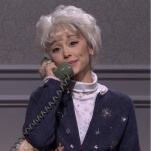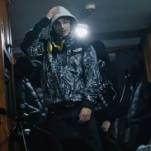Celebrity Hot Potato, 6/29/84
The end was already nigh for the daytime network TV game show by the time Hot Potato debuted on January 23, 1984. Having survived the scandals of the ’50s, game shows grew in popularity through the ’60s thanks a few tried-and-true formats, like the “panel show”—where an assortment of Broadway stars and noted raconteurs asked questions of average Joes—and games where ordinary folks were asked to perform silly stunts or solve little brain-teasers. In the ’70s, the genre exploded, as The Price Is Right, Match Game, Pyramid, Family Feud, and Wheel Of Fortune anchored daytime lineups, surrounded by dozens of colorful, sometimes crazy shows. (The Magnificent Marble Machine, anyone?) But by the ’80s, the networks were increasingly leaving the gaming business up to the syndicators, while saving their own airtime for soap operas and talk shows, which were proving more lucrative. The golden age was over.
Hot Potato followed a fairly typical game show arc for the time. The game itself wasn’t terribly original: Like Family Feud and Card Sharks, the questions relied largely on public surveys, the results of which the contestants were asked to list one at a time. Hot Potato’s big gimmick was that it was played by two teams of three, who had the option to name an item on the list or to challenge an opponent to come up with one. (It was Family Feud with more strategy, in other words.) The show failed to catch on in its original format, with teams of civilians related by occupation or hobby, and so on April 23, NBC and Barry & Enright Productions relaunched the program as Celebrity Hot Potato—a change that savvy fans of the genre recognized as a last gasp. Run down the list of short-lived ’80s game shows and you’ll find that a significant number added a celebrity element just before their inevitable cancellation.
One big problem—circa 1984, anyway—was that celebrities weren’t what they had been. Stars were a common component of the game show heyday of the ’60s and ’70s too, though even then, the “stars” in question were usually old comedians, ingénues, or fourth-billed character actors promoting their new TV series. Some, like Charles Nelson Reilly, Paul Lynde, and Brett Somers, became more famous for being on game shows than they ever were as actors. Some, like Richard Dawson, made the transition from the panel to hosting. And many picked up an extra paycheck in primetime once shows like Love Boat and Fantasy Island gave the C-list a comfy home. The end result was celeb-glut. The mere presence of a famous face on TV became less than enticing.
Then there was the added problem of exactly how these celebrities were meant to behave. Why were they there, exactly? To help the contestant, or to be entertaining? There were some shows—like Password and Pyramid—where the guest stars were expected to know the game and to come to compete. Others—like Hollywood Squares and Match Game—were far looser. Match Game became the biggest hit in daytime when it was revived in 1973, and drew numbers to rival primetime programming during its peak year of 1975, which led to the show’s shrewdest and most popular player, Richard Dawson, being tapped to host Family Feud. During Family Feud’s biggest ratings years, Dawson was a swaggering presence who had enough leverage to insist on beginning each show with a short monologue. That’s how popular the “game show celebrities” were in the ’70s.
Yet the Saturday Night Live cliché of the idiotic celeb contestant—seen in Will Ferrell and Norm Macdonald’s Celebrity Jeopardy sketches, or in the recent Secret Word—didn’t come out of nowhere. Like nearly every other game show, Hollywood Squares and Match Game would tape five episodes a day, and they became notorious for their liquid dinner breaks, which meant that the Thursday and Friday episodes of any given week sometimes verged on mayhem. And whatever the show, some celebrities—older comedians in particular—were always going to be more interested in cutting up than playing the game, even if that left their poor non-celeb partners in the lurch.
Which brings us to the June 29, 1984 episode of Celebrity Hot Potato. The show begins with Carrie Olsen, a freelance photographer, competing alongside former Laugh-In star Arte Johnson and Happy Days’ Anson Williams against Rod Garrett, a pier coordinator, on a team with veteran comic Jan Murray and Broadway legend Lainie Kazan. (Later, Carrie is supplanted by Trudi Miller, a “certified aerobics instructor.”) This is the last-ever Celebrity Hot Potato, and everyone involved knew it. In the opening, Johnson jokes with host Bill Cullen that it’s “nice to be on the Titanic with you,” while Murray says that he wishes he were Cullen so he could kick back and draw unemployment checks. There’s a little bit of last-day-of-school cynicism and silliness to the celeb behavior—though to be honest, they’d probably be acting this way even if they were guesting on a hit show that had just been renewed.
The rules of Hot Potato weren’t exactly celebrity-friendly. The first question of the June 29 episode asks the contestants to name seven of the eight characters who’ve appeared most often in the comic strip Dennis The Menace which is a subject that Williams handles well but which leaves the rest of the celebs utterly confused. Cullen tries to elicit responses from stars who don’t know what the hell he’s talking about, and since Cullen’s only allowed to list the already-given answers once each round, he can’t provide any real guidance. Murray tries to play along the best he can, but Johnson gives a joke answer—“Norman Feldkaiser!”—and then immediately turns around to take his seat on the bench, where he looks exaggeratedly bored and irritated for the remainder of the game.








































